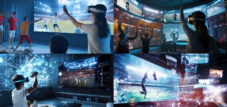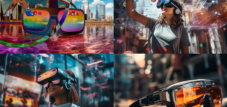Is MetaQuest 3 still the global market leader? Standalone VR and Mixed Reality: The global battle for the digital future
Xpert pre-release
Language selection 📢
Published on: November 26, 2025 / Updated on: November 26, 2025 – Author: Konrad Wolfenstein

Is Meta Quest 3 still the global market leader? Standalone VR and Mixed Reality: The global battle for the digital future – Image: Xpert.Digital
Meta's 84 percent monopoly: Why the VR market is still shrinking and smart glasses are booming
Samsung and Google launch their attack on Meta's empire, and why Germany is focusing on industry rather than gaming in VR.
2025 marks a crucial milestone in the development of immersive technologies.” What once began as a niche area for gamers and tech enthusiasts has now evolved into a global arena for political and technological power plays, laying the foundations for the next era of personal computing.
The market for virtual reality (VR) and mixed reality (MR) presents itself as a field full of contradictions: While Meta, with its Quest series, demonstrates an almost overwhelming dominance of up to 84 percent market share in certain quarters, classic VR headsets are struggling with declining sales figures globally. At the same time, smart glasses and augmented reality applications are experiencing explosive growth of over 100 percent, signaling a fundamental paradigm shift – away from isolation and towards the seamless integration of digital content into everyday life.
But the question of the future of digital reality cannot be answered simply by looking to Silicon Valley. A more nuanced analysis reveals a profound fragmentation of global markets: While the US is battling for the next major platform between Meta's mass-market approach and Apple's premium strategy, Europe is pursuing a pragmatic, industry-oriented path that prioritizes data privacy and efficiency. Meanwhile, Asia – and China in particular – has long since emerged as the most dynamic force, driven by government support, innovation-driven local champions like Pico, and broad public acceptance.
The following article illuminates the complex dynamics of this "battle for the digital future." It analyzes how tech giants like Samsung and Google are mobilizing against Meta's quasi-monopoly, why smart glasses have the potential to replace the smartphone, and why the true technological breakthrough may not occur in the living room, but rather on the factory floor and through ultralight wearables. We take a look at an industry in flux, oscillating between astronomical investments, technological quantum leaps, and the constant search for the "iPhone moment" of mixed reality.
When a company dominates almost the entire market and yet the world still talks about a technological revolution
The virtual and augmented reality landscape is at a critical turning point in 2025. What was considered a niche market for tech-savvy early adopters just a few years ago is evolving into a strategic battleground for global technology corporations. The question of whether Meta Quest 3 will remain the market-leading XR platform cannot be answered with a simple yes or no, but requires a nuanced analysis of regional markets, cultural differences, and economic dynamics in the US, Europe, Asia, and especially China.
The global VR headset market presents a paradoxical picture: On the one hand, Meta dominates the sector with a market share of around 75 percent, to such an extent that critics speak of a de facto monopoly. On the other hand, the overall VR headset market is projected to decline by approximately 14 to 21 percent in 2025 compared to the previous year, while AR glasses and smart glasses are experiencing explosive growth rates of over 100 percent. This divergence reveals the fundamental transformation of an industry evolving from isolated VR experiences to integrated mixed-reality solutions.
The American perspective: Between market dominance and strategic realignment
In the United States, the XR debate primarily manifests as a competition between established technology giants and the question of the next computing platform. The US VR market is estimated at approximately $4.5 billion in 2025 and is projected to grow to $57.5 billion by 2035, representing an average annual growth rate of nearly 29 percent. These figures reflect the fundamental optimism of American investors and companies regarding the long-term importance of immersive technologies.
Meta Platforms, the company behind the Quest product line, is investing over $100 billion in AR, VR, and smart glasses infrastructure by the end of 2025. These astronomical sums underscore the strategic importance that CEO Mark Zuckerberg attaches to developing a new computing platform. The company is pursuing a two-pronged strategy: The Quest headsets are aimed at the mass market, while the smart glasses developed in collaboration with Ray-Ban are intended to provide an alternative way to access augmented reality.
The American consumer perspective is characterized by practical considerations regarding price-performance ratio and content offerings. The Meta Quest 3, with a starting price of $499, and the even more affordable Quest 3S, starting at $299, effectively meet this demand. Particularly noteworthy is Meta's dominance in the fourth quarter of 2024, when the company achieved an 84 percent market share thanks to the launch of the Quest 3S. However, this concentration raises questions about market health and competition.
The American business environment is showing growing interest in XR solutions for training, simulation, and remote collaboration. It is estimated that enterprise applications now generate approximately 70 percent of total XR revenue. Fortune 500 companies are increasingly using XR technologies for training purposes, with VR-based training enabling cost reductions of up to 52 percent compared to traditional methods. This development is increasingly shifting the focus of the American XR industry from the consumer to the enterprise market.
Apple entered the XR market in February 2024 with the Vision Pro, priced at $3,499, pursuing a radically different strategy than Meta. The company explicitly positioned its device as a premium product for early adopters and developers, not as a mass-market device. Estimated sales figures of 370,000 to 500,000 units in 2024 confirmed this positioning and resulted in a market share of approximately 5 percent. CEO Tim Cook acknowledged that the Vision Pro was not a mass-market product at this price point but emphasized the intention to remain in this segment long-term.
Valve, the operator of the Steam platform and developer of the Valve Index, is preparing a potential successor with the Steam Frame. The company is deliberately distancing itself from the Index brand to emphasize the paradigm shift: the Steam Frame is intended to be not just a VR accessory for gaming PCs, but a standalone computer. Currently, around 15 percent of SteamVR players use the Valve Index headset, but the new strategy aims for a broader user base without PC dependency.
European assessments: Industry focus and regulatory prudence
The European perspective on the XR market differs fundamentally from the American approach. While the US focuses on the consumer market and gaming, Europe concentrates more on industrial applications, education, and regulatory frameworks. The European VR market is estimated at approximately US$2.3 billion in 2025 and is projected to grow to over US$30 billion by 2035.
As Europe's largest economy, Germany occupies a key position. The German VR headset market generated revenues of approximately US$320 million in 2023 and is projected to grow to US$1.76 billion by 2030. This growth is largely driven by demand from the automotive, mechanical engineering, and manufacturing sectors, where VR solutions are used for prototyping, design visualization, and employee training.
European demand is characterized by a preference for high-end devices. In Germany, the high-end segment accounted for approximately 55 percent of the market share in 2023. This reflects the requirements of professional users in industry and research who value high resolution, precise tracking, and reliable performance. Manufacturers such as HTC with its Vive series and the Finnish startup Varjo with its high-resolution headsets for design and simulation applications are successfully serving this segment.
The launch of Samsung's Galaxy XR, the first Android XR-based headset, is being followed with particular interest in Europe. The device, initially priced at $1,799 in the US and South Korea, boasts technical specifications that rival Apple's Vision Pro, featuring two 3,552 x 3,840 pixel micro-OLED displays, a 109-degree horizontal field of view, and the Snapdragon XR2+ Gen 2 processor. The partnership between Samsung, Google, and Qualcomm creates an alternative ecosystem to Meta's closed approach and Apple's premium strategy.
European industry is increasingly recognizing the added value of XR technologies for training and maintenance. Manufacturing companies report cost reductions of up to 40 percent in employee training and shorter onboarding times of 60 percent. These quantifiable benefits are also convincing more conservative European decision-makers, who traditionally place higher demands on demonstrating a return on investment.
Sony's PlayStation VR2 has garnered a loyal following in Europe, particularly among console gamers. With a resolution of 2,000 by 2,040 pixels per eye, eye tracking, and haptic feedback, the device offers a high-quality VR experience for PlayStation 5 owners. The ability to connect the headset to PCs further expands its user base, making it the only VR headset capable of playing on both platforms. Aggressive price reductions during Black Friday 2025, bringing the price below €300, indicate Sony's efforts to broaden its user base.
The regulatory landscape in Europe also influences XR development. Data privacy concerns regarding the extensive sensors in modern headsets, which track eye movements, posture, and the environment, necessitate careful compliance strategies from vendors. This sensitivity to data privacy issues differentiates the European market from other regions and impacts product decisions and marketing strategies.
Asian Dynamics: Innovation, Growth and Regional Champions
The Asia-Pacific region represents the most dynamic segment of the global XR market. With a share of over 50 percent of global VR headset sales in 2024 and a projected average annual growth rate of 31 percent until 2034, the region surpasses all other markets. This dominance can be explained by several factors: a tech-savvy population, strong local manufacturers, comprehensive government support programs, and an established gaming culture.
Japan, South Korea, and China constitute the region's three main markets, each with its own distinct characteristics. Japan's focus is on AR applications for retail and education, supported by a strong gaming culture and investments in contextual digital experiences. The Japanese government, through the Ministry of Economy, Trade and Industry, promotes content creators who utilize innovative technologies like VR for marketing purposes.
South Korea boasts an advanced technological infrastructure that facilitates the adoption of standalone VR devices. The government has already invested heavily in AR and VR initiatives and established centers such as the Korean Virtual Reality Augmented Reality Complex in Seoul. With Samsung as a global electronics giant and the upcoming Galaxy XR, South Korea will play a pivotal role in shaping the next generation of XR.
HTC's role as a Taiwanese pioneer deserves special mention. Along with Oculus and Valve, the company was one of the trailblazers of the modern VR industry. HTC Vive headsets are still considered leading PC VR devices. However, HTC has struggled to adapt to the market trend toward standalone headsets, although the company continues to innovate with peripherals like the Vive Tracker.
The expansion of 5G infrastructure across the region is acting as a catalyst for XR applications. Low latency and high bandwidth enable cloud-based XR experiences that offload computationally intensive tasks to remote servers, thereby reducing the demands on local hardware. This development democratizes access to high-quality VR experiences and opens up new use cases in areas such as remote collaboration and real-time multiplayer gaming.
The burgeoning VR ecosystem in India and other emerging Asian countries deserves attention. Government initiatives and rising disposable incomes are driving adoption, even though the market is still in its early stages. The combination of a young, digitally savvy population and growing economic purchasing power creates long-term growth prospects.
🗒️ Xpert.Digital: A pioneer in the field of extended and augmented reality
Strategic Technology Offensive: China's Path to XR Dominance
China's special position: National champions and strategic technology development
China occupies a unique position in the global XR competition. As the world's largest single market for VR headsets, with projected sales of approximately US$3.2 billion in 2025 and an expected growth rate of over 26 percent by 2035, the country significantly outperforms the global average. This dynamic is enabled by a combination of government support, local champions, and a large manufacturing base.
Pico, owned by TikTok's parent company ByteDance, dominates the Chinese VR market with a share of over 58 percent. The company, which has been developing VR headsets since 2015 and was acquired by ByteDance in 2021, benefits from significant investment and a clear strategy for the enterprise market. While Pico products never achieved the success of the MetaQuest outside of China, the company remains a major player in its home market and is increasingly expanding into enterprise applications.
The Chinese government supports the XR industry through targeted initiatives. The Shenzhen municipal government, in cooperation with HTC, established a $1.45 billion VR investment fund, complemented by the creation of a China VR Research Institute to promote the local VR ecosystem. This government support reflects the strategic importance China attaches to immersive technologies as part of its technological sovereignty strategy.
China's leading role in developing affordable VR solutions is noteworthy. Companies like Vivo have unveiled the Vision Discovery Edition, a mixed-reality headset that, at just 398 grams, is about 35 percent lighter than Apple's Vision Pro. The device features two 8K micro-OLED displays, each with a resolution of 3,840 by 3,552 pixels, and is powered by the Qualcomm Snapdragon XR2+ Gen 2 processor. Initial reports suggest a price of around 10,000 yuan, equivalent to approximately US$1,400, representing a significant price advantage over premium Western headsets.
ByteDance is reportedly working on a new mixed-reality device for a potential market launch in 2027. The company is developing specialized chips that process sensor data and aim to minimize latency issues between visual representation and physical movements. These efforts demonstrate the long-term perspective of Chinese technology companies despite short-term market fluctuations.
A key difference compared to the West lies in the absence of Meta's Quest products in the official Chinese market. This gap creates opportunities for local providers and alternative ecosystems. At the same time, it makes it more difficult for Western companies to access the world's largest VR market and encourages the development of independent Chinese technology standards.
The integration of XR technologies into Chinese metaverse initiatives and e-commerce platforms also differs from the Western model. While gaming and entertainment dominate in the US, applications in virtual shopping experiences, social networks, and vocational training are increasingly prevalent in China. These differing usage patterns influence product development and market strategies.
The transformation of the competitive landscape: Beyond hardware
An analysis of the XR market would be incomplete without considering the fundamental shift the industry is currently undergoing. The traditional focus on VR headsets is giving way to a broader definition of augmented reality that includes smart glasses, AR glasses, and mixed reality devices.
Meta's Ray-Ban smart glasses exemplify this shift. With over 2 million units sold and sales tripling in the second quarter of 2025, this product is becoming the most successful AI hardware product of the past three years. The smart glasses market as a whole grew by 110 percent in the first half of 2025, with Meta maintaining its leading position with a 73 percent share. However, Chinese vendors such as Xiaomi and TCL-RayNeo are increasingly gaining market share.
The latest generation of Ray-Ban Meta Glasses, including the $799 display variant, features a full-color, high-resolution display that appears and disappears as needed, along with real-time subtitles and translations in select languages. The partnership with EssilorLuxottica, the world's largest eyewear manufacturer, solves the classic problem of smart glasses: they look like regular glasses that people actually want to wear.
The enterprise market is emerging as the primary growth driver. Estimates suggest that by 2030, approximately 60 percent of total VR revenue will come from enterprise applications. This shift reflects the increasing acceptance of quantifiable benefits: higher training retention rates of up to 75 percent compared to traditional methods, shorter onboarding times, and reduced travel costs for remote collaboration.
The quality of available content remains a critical factor for market development. Meta continues to invest significantly in its Quest ecosystem, with Oculus Publishing releasing over 100 titles in 2024 and more than 200 others in active development. To date, over $2 billion has been spent on Meta Quest content, with annual revenue increasing by approximately 12 percent in 2024 compared to the previous year. These figures underscore the importance of a robust content ecosystem for the platform's success.
The technological convergence between standalone and PC VR devices is blurring traditional product categories. Most major titles now support both platforms, increasing user flexibility and facilitating the transition between different use cases. Cloud XR processing, which offloads computationally intensive tasks to servers, reduces hardware requirements while simultaneously improving visual quality.
Technological developments: The next generation
The next generation of XR devices promises significant improvements in weight, resolution, battery life, and processing power. Qualcomm's Project Matrix, known by the codenames XR2 Gen 3 and XR2+ Gen 3, is already undergoing internal testing and integration by headset manufacturers. Expected specifications include 16 GB of RAM, UFS 4.0 storage, and the new Oryon cores, representing a significant performance leap over current chips.
Pico is working on a headset for 2026 featuring 4K micro-OLED displays and a dedicated passthrough chip modeled after Apple's R1. The development of a specialized chip for real-time processing of camera images with latency below 12 milliseconds demonstrates the increasing specialization of hardware architecture.
Apple is reportedly planning an updated Vision Pro with the M5 chip and a new headband for improved comfort. This enhanced everyday usability addresses one of the main criticisms of the current model and could increase its appeal to professional users who want to wear the device for extended periods.
Miniaturization and the pursuit of lighter devices dominate development agendas. ByteDance and Meta are both working on ultra-compact VR headsets, with Pico's new concept featuring a glasses-like form factor and a separate computing module housed in a pocket. This approach sacrifices some features in favor of increased portability and social acceptance.
Market forecasts and economic implications
Despite short-term volatility, long-term forecasts for the XR market remain optimistic. The global XR market is projected to grow from approximately US$20 billion in 2025 to over US$85 billion by 2030, representing an average annual growth rate of about 33 percent. Some analysts project the overall spatial computing market to grow to over US$1.6 trillion by 2032.
These forecasts are based on assumptions of increasing enterprise adoption, improved hardware, and expanding content ecosystems. However, risks include ongoing challenges with consumer adoption, regulatory uncertainties, and the possibility of disruptive technologies that could render current platforms obsolete.
The economic impact extends beyond the direct hardware and software industries. Manufacturing VR headsets and their components creates jobs along complex supply chains, from display manufacturers and sensor producers to chip designers. China dominates manufacturing, while design and software development are more concentrated in the US and Europe.
The investment landscape reflects the growing interest of institutional investors. EssilorLuxottica, Meta's partner for Ray-Ban glasses, saw its share price rise by almost 14 percent after announcing strong quarterly results, reaching an all-time high. Analysts predict that smart glasses could become the most disruptive innovation since mobile phones, with a forecast of 60 million units sold annually.
Regional competitive dynamics and strategic positioning
The fragmentation of the global XR market along regional lines creates distinct competitive landscapes. In North America, Meta, Apple, and Sony compete for premium consumers, while Valve's Steam Frame serves a niche market for demanding PC gamers. The enterprise market is dominated by Meta Quest for Business, Microsoft HoloLens, and specialized vendors like Varjo.
Europe is showing greater penetration of industrial applications and a higher preference for privacy-compliant solutions. The automotive, mechanical engineering, and healthcare sectors are driving demand for professional XR devices. Local system integrators play a key role in implementing and adapting XR solutions to specific business requirements.
The Asia-Pacific region, led by China, is developing into the largest and most dynamic market. Local champions like Pico, Vivo, and potentially Xiaomi are challenging Western providers with aggressively priced alternatives. Strong government support and the integration of XR into national digitalization strategies are creating favorable conditions for further growth.
The question of platform dominance remains open. Meta's closed ecosystem offers advantages in terms of integration and user experience, but carries risks regarding dependency and competition. Google's Android XR, debuting with Samsung's Galaxy XR, promises greater openness and could, similar to Android in the smartphone market, offer an alternative for manufacturers who don't want to develop their own operating systems.
Apple's premium positioning strategy hasn't yet translated into mass-market success, but it has established quality standards against which competitors must measure themselves. The company's ability to integrate hardware, software, and services could offer long-term advantages once more affordable devices become available. However, the reliance on a limited content catalog of approximately 2,500 native apps in the visionOS App Store remains a challenge.
Challenges and obstacles to market development
Despite optimistic forecasts, the XR market faces significant challenges. The high cost of advanced VR technology limits its adoption, particularly in price-sensitive markets and among small and medium-sized enterprises. Developing compelling content requires substantial investment, and many applications do not yet justify the hardware purchase for the average consumer.
Technical limitations such as limited battery life, ergonomic challenges, and the need for precise calibration negatively impact the user experience. The typical battery life of two to two and a half hours under intensive use is insufficient for many applications. The weight and pressure points of the headsets can lead to discomfort during extended use, limiting their adoption for work applications.
Data privacy and security concerns present regulatory and ethical hurdles. The extensive sensor technology of modern XR devices, including eye tracking, spatial scanning, and biometrics, captures sensitive personal data that must be protected. Differing regulatory frameworks in various regions complicate global product strategies.
The fragmentation of content formats and interoperability issues hinder the seamless integration of different platforms. Developers often have to create separate versions for different headsets, which increases costs and slows innovation. Standardization efforts are underway, but a unified ecosystem like that of smartphones is not yet in sight.
Health concerns, particularly regarding motion sickness and eye strain, limit the potential user base. Although technological advances reduce these problems, they remain relevant for a significant portion of the population and require careful consideration during product development.
Meta Quest 3 defends its market leadership – but the competition is upping its game.
Answering the initial question of whether Meta Quest 3 will remain the market-leading XR platform requires a nuanced analysis. In terms of absolute market share for standalone VR headsets, Meta's dominance will remain unchallenged in 2025. With shares between 74 and 84 percent depending on the quarter, the company controls the largest portion of the market.
However, the competitive landscape is evolving rapidly. Samsung's Galaxy XR with Android XR is establishing a serious alternative, especially for users who prefer a more open ecosystem. Apple's Vision Pro is setting quality standards that will influence the entire market in the long run. Chinese manufacturers like Pico, Vivo, and ByteDance are working on affordable alternatives that could challenge Meta's mass-market strategy.
The shift from pure VR to mixed reality and smart glasses is changing the very definition of the market. Meta's success with Ray-Ban smart glasses shows that the company is well-positioned even within this broader definition, but competition is intensifying with the entry of other providers into the market.
This analysis has several strategic implications for companies and investors. First, the corporate market remains the most reliable growth area with quantifiable returns. Second, regional fragmentation necessitates differentiated market strategies. Third, decision-makers should monitor technological evolution, as upcoming generations of devices promise significant improvements that could influence current investment decisions.
The XR industry is at a turning point. The technology has reached a stage where practical applications offer real benefits, but mass adoption remains a challenge. The coming years will show whether the industry can live up to its long-term promises or whether XR will remain a niche technology for specialized applications. A regional perspective highlights that the answer to this question could vary across the globe, shaped by cultural preferences, economic conditions, and the strategic priorities of each market.
Your global marketing and business development partner
☑️ Our business language is English or German
☑️ NEW: Correspondence in your national language!
I would be happy to serve you and my team as a personal advisor.
You can contact me by filling out the contact form or simply call me on +49 89 89 674 804 (Munich) . My email address is: wolfenstein ∂ xpert.digital
I'm looking forward to our joint project.
☑️ SME support in strategy, consulting, planning and implementation
☑️ Creation or realignment of the digital strategy and digitalization
☑️ Expansion and optimization of international sales processes
☑️ Global & Digital B2B trading platforms
☑️ Pioneer Business Development / Marketing / PR / Trade Fairs
🎯🎯🎯 Benefit from Xpert.Digital's extensive, five-fold expertise in a comprehensive service package | BD, R&D, XR, PR & Digital Visibility Optimization

Benefit from Xpert.Digital's extensive, fivefold expertise in a comprehensive service package | R&D, XR, PR & Digital Visibility Optimization - Image: Xpert.Digital
Xpert.Digital has in-depth knowledge of various industries. This allows us to develop tailor-made strategies that are tailored precisely to the requirements and challenges of your specific market segment. By continually analyzing market trends and following industry developments, we can act with foresight and offer innovative solutions. Through the combination of experience and knowledge, we generate added value and give our customers a decisive competitive advantage.
More about it here:





















